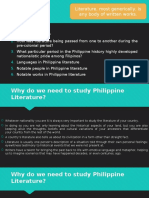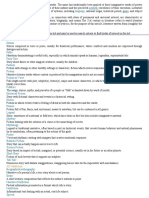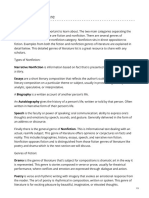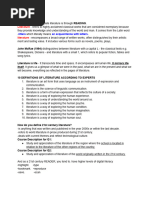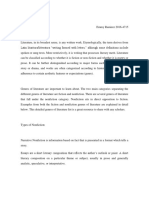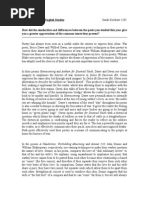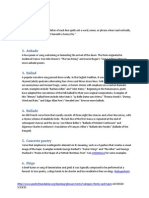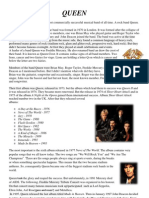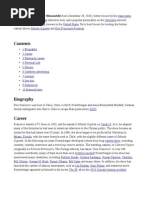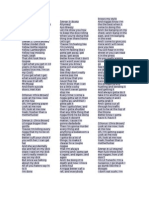Phil Litreture
Phil Litreture
Uploaded by
Marchie Halili VillaranteCopyright:
Available Formats
Phil Litreture
Phil Litreture
Uploaded by
Marchie Halili VillaranteOriginal Description:
Original Title
Copyright
Available Formats
Share this document
Did you find this document useful?
Is this content inappropriate?
Copyright:
Available Formats
Phil Litreture
Phil Litreture
Uploaded by
Marchie Halili VillaranteCopyright:
Available Formats
INTRODUCTION: "Philippine Literature"
An Introduction...
Philippine Literature is a diverse and rich group of
works that has evolved side-by-side with the countrys history. Literature had
started with fables and legends made by the ancient Filipinos long before the
arrival of Spanish influence. The main themes of Philippine literature focus on
the countrys pre-colonial cultural traditions and the socio-political histories of
its colonial and contemporary traditions.
It is not a secret that many Filipinos are unfamiliar with much of the
country's literary heritage, especially those that were written long before the
Spaniards arrived in our country. This is due to the fact that the stories of ancient
time were not written, but rather passed on from generation to generation
through word of mouth. Only during 1521 did the early Filipinos became
acquainted with literature due to the influence of the Spaniards on us. But the
literature that the Filipinos became acquainted with are not Philippine-made,
rather, they were works of Spanish authors.
So successful were the efforts of colonists to blot out the memory of the
country's largely oral past that present-day Filipino writers, artists and journalists
are trying to correct this inequity by recognizing the country's wealth of ethnic
traditions and disseminating them in schools through mass media.
The rise of nationalistic pride in the 1960s and 1970s also helped bring
about this change of attitude among a new breed of Filipinos concerned about the
"Filipino identity."
Philippine literature is written in Spanish, English, Tagalog, and/or other
native Philippine Languages.
Why do we need to study Philippine Literature?
Whatever nationality you are it is always very important to study the
literature of your country. In doing so you are not only learning about the
historical aspects of your land, but you are also keeping alive the thoughts, beliefs
and cultural variations of your ancestors that differentiate your country from the
rest of the world.
A country's literature also tells us about its civilization in a form other than
straight fact. Literature is usually one person's description of a situation told
through their own personal feelings; eyewitness testimony to historical
events that we were not present at. Writers have a talent for bringing the past
back to life with emotive language and metaphor, helping us to imagine
scenarios that may have happened decades, or even centuries, ago.
LITERATURE BY LANGUAGES
Cebuano literature
Hiligaynon literature
Ilokano literature
Tagalog literature
Waray literature
Philippine Poetry
Philippine Literature in English
Philippine Literature in Filipino
Philippine Literature in Spanish
NOTABLE PEOPLE
Jose Rizal
Marcelo H. Del Pilar
Carlos P. Romulo
Francisco Balagtas
Amado V. Hernandez
Carlos Bulosan
Teodoro M. Locsin
Claro M. Recto
NOTABLE WORKS
Noli Me Tangere
El Filibusterismo
Biag ni Lam-ang
Ibong Adarna Francisco baltazar
Florante at Laura
Doctrina Christiana
LITERARY GENRES
Genres of literature are important to learn about. The two main categories
separating the different genres of literature are fiction and nonfiction. There are
several genres of literature that fall under the nonfiction category. Nonfiction sits
in direct opposition to fiction. Examples from both the fiction and nonfiction
genres of literature are explained in detail below.
Types of Nonfiction:
Narrative Nonfiction is information based on fact that is presented in a
format which tells a story.
Essays are a short literary composition that reflects the authors outlook or
point. A short literary composition on a particular theme or subject, usually in
prose and generally analytic, speculative, or interpretative.
A Biography is a written account of another persons life.
An Autobiography gives the history of a persons life, written or told by
that person. Often written in Narrative form of their persons life.
Speech is the faculty or power of speaking; oral communication; ability to
express ones thoughts and emotions by speech, sounds, and gesture. Generally
delivered in the form of an address or discourse.
Genres of Fiction:
Drama is the genre of literature thats subject for compositions is dramatic
art in the way it is represented. This genre is stories composed in verse or prose,
usually for theatrical performance, where conflicts and emotion are expressed
through dialogue and action.
Poetry is verse and rhythmic writing with imagery that evokes an
emotional response from the reader. The art of poetry is rhythmical in
composition, written or spoken. This genre of literature is for exciting pleasure
by beautiful, imaginative, or elevated thoughts.
Fantasy is the forming of mental images with strange or other worldly
settings or characters; fiction which invites suspension of reality.
Humor is the faculty of perceiving what is amusing or comical. Fiction full
of fun, fancy, and excitement which meant to entertain. This genre of literature
can actually be seen and contained within all genres.
A Fable is a story about supernatural or extraordinary people Usually in
the form of narration that demonstrates a useful truth. In Fables, animals often
speak as humans that are legendary and supernatural tales.
Fairy Tales or wonder tales are a kind of folktale or fable. Sometimes the
stories are about fairies or other magical creatures, usually for children
Science Fiction is a story based on impact of potential science, either actual
or imagined. Science fiction is one of the genres of literature that is set in the
future or on other planets.
Short Story is fiction of such briefness that is not able to support any
subplots.
Realistic Fiction is a story that can actually happen and is true to real life.
Folklore are songs, stories, myths, and proverbs of a person of folk that
was handed down by word of mouth. Folklore is a genre of literature that is
widely held, but false and based on unsubstantiated beliefs.
Historical Fiction is a story with fictional characters and events in a
historical setting.
Horror is an overwhelming and painful feeling caused by literature that is
frightfully shocking, terrifying, or revolting. Fiction in which events evoke a
feeling of dread in both the characters and the reader.
A Tall Tale is a humorous story with blatant exaggerations, swaggering
heroes who do the impossible with an here of nonchalance.
Legend is a story that sometimes of a national or folk hero. Legend is based
on fact but also includes imaginative material.
Mystery is a genre of fiction that deals with the solution of a crime or the
unraveling of secrets. Anything that is kept secret or remains unexplained or
unknown.
Mythology is a type of legend or traditional narrative. This is often based in
part on historical events, that reveals human behavior and natural phenomena
by its symbolism; often pertaining to the actions of the gods. A body of myths, as
that of a particular people or that relating to a particular person.
Fiction in Verse is full-length novels with plot, subplots, themes, with
major and minor characters. Fiction of verse is one of the genres of literature in
which the narrative is usually presented in blank verse form.
Synopsis
At birth, Lam-Ang was already able to speak. He gave himself his own name, chose his own godparents and also asked for his
father. But Lam-ang's father, Don Juan, went away to fight an evil tribe ofIgorots nine months before Lam-ang's birth. Don Juan died
at the hands of the tribe and was beheaded. His head was set as a prize at the village's center. Due to Don Juan's absence at the
birth of his son, Lam-ang set out to find his father.
With the assistance of a different tribe of Igorots, Lam-ang was able to avenge his father's death. Using a single spear, he defeated
every one of the headhunters of the warring Igorot tribe.
When Lam-ang went to bathe in the Amburayan River on his way home, the water was immediately dirtied by his blood-stained
body. The water became so muddied with blood that all its living creatures crawled out of it and died.
The day after his return, Lam-ang told his mother, Ina Namongan, that he wished to take a wife. As Lam-ang was endowed with
supernatural powers, he was able to foretell that he would marry a woman called Ines Kannoyan who lived in a place called
Calanutian. And so Lam-ang set off on his journey to win his wife. With him were his pet rooster and dog. On the way, Lam-ang had
to fight a large-eyed man called Sumarang, whom he defeated in the encounter.
Ines Kannoyan was very beautiful. When Lam-ang arrived, Ines Kannoyan's house was so crowded by her suitors that Lam-ang
was able to enter her house only by walking over the suitors' heads and climbing through a window.
Ines Kannoyan was impressed by Lam-ang's strength and abilities. By flapping its wings, Lam-ang's rooster was able to bring down
Ines Kannoyan's long house. And with a bark, Lam-ang's dog was able to raise the long house again.
Despite having won Ines Kannoyan's favor, Lam-ang still could not marry her because her parents wanted a dowry from the hero. At
this, Lam-ang promised to come back in a week with his mother and the dowry.
Lam-ang went home to prepare a rich dowry. He had a house adorned with gold and filled it with gifts of fruit, jewels, and other
riches. When Lam-ang returned to Ines Kannoyan's family to present the dowry, they were so impressed that they had they held the
wedding immediately.
After this, Lam-ang was asked to catch fish from the Aburayan River. Diving into the water, the hero was swallowed by the great
river monster, Berkakan. Ines Kannoyan was in terrible grief over the death of her husband.
Lacay Marcos, an old diver from the village, was asked to retrieve Lam-ang's remains after Berkakan had expelled them. Lam-ang's
rooster and dog performed magical rites over his remains, and Lam-ang was brought back to life.
The Literary Forms in Philippine Literature
by: Christine F. Godinez-Ortega
The diversity and richness of Philippine literature evolved side by side with the
country's history. This can best be appreciated in the context of the country's pre-
colonial cultural traditions and the socio-political histories of its colonial and
contemporary traditions.
The average Filipino's unfamiliarity with his indigenous literature was largely due
to what has been impressed upon him: that his country was "discovered" and, hence,
Philippine "history" started only in 1521.
So successful were the efforts of colonialists to blot out the memory of the
country's largely oral past that present-day Filipino writers, artists and journalists are
trying to correct this inequity by recognizing the country's wealth of ethnic traditions
and disseminating them in schools and in the mass media.
The rousings of nationalistic pride in the 1960s and 1970s also helped bring about
this change of attitude among a new breed of Filipinos concerned about the "Filipino
identity."
Pre-Colonial Times
Owing to the works of our own archaeologists, ethnologists and anthropologists,
we are able to know more and better judge information about our pre-colonial times
set against a bulk of material about early Filipinos as recorded by Spanish, Chinese,
Arabic and other chroniclers of the past.
Pre-colonial inhabitants of our islands showcase a rich past through their folk
speeches, folk songs, folk narratives and indigenous rituals and mimetic dances that
affirm our ties with our Southeast Asian neighbors.
The most seminal of these folk speeches is the riddle which is tigmo in
Cebuano, bugtong in Tagalog, paktakon in Ilongo and patototdon in Bicol. Central to
the riddle is the talinghaga or metaphor because it "reveals subtle resemblances
between two unlike objects" and one's power of observation and wit are put to the test.
While some riddles are ingenious, others verge on the obscene or are sex-related:
Gaddang:
Gongonan nu usin y amam If you pull your daddy's penis
Maggirawa pay sila y inam. Your mommy's vagina, too,
(Campana) screams. (Bell)
The proverbs or aphorisms express norms or codes of behavior, community
beliefs or they instill values by offering nuggets of wisdom in short, rhyming verse.
The extended form, tanaga, a mono-riming heptasyllabic quatrain expressing
insights and lessons on life is "more emotionally charged than the terse proverb and
thus has affinities with the folk lyric." Some examples are the basahanon or extended
didactic sayings from Bukidnon and the daraida and daragilon from Panay.
The folk song, a form of folk lyric which expresses the hopes and aspirations, the
people's lifestyles as well as their loves. These are often repetitive and sonorous,
didactic and naive as in the children's songs or Ida-ida(Maguindanao), tulang
pambata (Tagalog) or cansiones para abbing (Ibanag).
A few examples are the lullabyes or Ili-ili (Ilongo); love songs like
the panawagon and balitao (Ilongo); harana or serenade (Cebuano);
the bayok (Maranao); the seven-syllable per line poem, ambahan of the Mangyans
that are about human relationships, social entertainment and also serve as a tool for
teaching the young; work songs that depict the livelihood of the people often sung to
go with the movement of workers such as the kalusan (Ivatan), soliranin (Tagalog
rowing song) or the mambayu, a Kalinga rice-pounding song; the verbal jousts/games
like the duplo popular during wakes.
Other folk songs are the drinking songs sung during carousals like the tagay
(Cebuano and Waray); dirges and lamentations extolling the deeds of the dead like
the kanogon (Cebuano) or the Annako (Bontoc).
A type of narrative song or kissa among the Tausug of Mindanao, the parang
sabil, uses for its subject matter the exploits of historical and legendary heroes. It tells
of a Muslim hero who seeks death at the hands of non-Muslims.
The folk narratives, i.e. epics and folk tales are varied, exotic and magical. They
explain how the world was created, how certain animals possess certain
characteristics, why some places have waterfalls, volcanoes, mountains, flora or fauna
and, in the case of legends, an explanation of the origins of things. Fables are about
animals and these teach moral lessons.
Our country's epics are considered ethno-epics because unlike, say, Germany's
Niebelunginlied, our epics are not national for they are "histories" of varied groups
that consider themselves "nations."
The epics come in various
names: Guman (Subanon); Darangen (Maranao); Hudhud (Ifugao);
and Ulahingan (Manobo). These epics revolve around supernatural events or heroic
deeds and they embody or validate the beliefs and customs and ideals of a community.
These are sung or chanted to the accompaniment of indigenous musical instruments
and dancing performed during harvests, weddings or funerals by chanters. The
chanters who were taught by their ancestors are considered "treasures" and/or
repositories of wisdom in their communities.
Examples of these epics are the Lam-
ang (Ilocano); Hinilawod (Sulod); Kudaman (Palawan); Darangen (Maranao); Ulahin
gan (Livunganen-Arumanen Manobo); Mangovayt Buhong na Langit (The Maiden of
the Buhong Sky from Tuwaang--Manobo); Ag Tobig neg Keboklagan (Subanon);
and Tudbulol (T'boli).
The Spanish Colonial Tradition
While it is true that Spain subjugated the Philippines for more mundane reasons,
this former European power contributed much in the shaping and recording of our
literature. Religion and institutions that represented European civilization enriched
the languages in the lowlands, introduced theater which we would come to know
as komedya, the sinakulo, the sarswela, the playlets and the drama. Spain also brought
to the country, though at a much later time, liberal ideas and an internationalism that
influenced our own Filipino intellectuals and writers for them to understand the
meanings of "liberty and freedom."
Literature in this period may be classified as religious prose and poetry and
secular prose and poetry.
Religious lyrics written by ladino poets or those versed in both Spanish and
Tagalog were included in early catechism and were used to teach Filipinos the
Spanish language. Fernando Bagonbanta's "Salamat nang walang hanga/gracias de
sin sempiternas" (Unending thanks) is a fine example that is found in the Memorial de
la vida cristiana en lengua tagala (Guidelines for the Christian life in the Tagalog
language) published in 1605.
Another form of religious lyrics are the meditative verses like the dalit appended
to novenas and catechisms. It has no fixed meter nor rime scheme although a number
are written in octosyllabic quatrains and have a solemn tone and spiritual subject
matter.
But among the religious poetry of the day, it is the pasyon in octosyllabic
quintillas that became entrenched in the Filipino's commemoration of Christ's agony
and resurrection at Calvary. Gaspar Aquino de Belen's "Ang Mahal na Passion ni Jesu
Christong Panginoon natin na tola" (Holy Passion of Our Lord Jesus Christ in Verse)
put out in 1704 is the country's earliest known pasyon.
Other known pasyons chanted during the Lenten season are in Ilocano,
Pangasinan, Ibanag, Cebuano, Bicol, Ilongo and Waray.
Aside from religious poetry, there were various kinds of prose narratives written
to prescribe proper decorum. Like the pasyon, these prose narratives were also used
for proselitization. Some forms are: dialogo(dialogue), Manual de
Urbanidad (conduct book); ejemplo (exemplum) and tratado (tratado). The most
well-known are Modesto de Castro's "Pagsusulatan ng Dalawang Binibini na si
Urbana at si Feliza" (Correspondence between the Two Maidens Urbana and Feliza)
in 1864 and Joaquin Tuason's "Ang Bagong Robinson" (The New Robinson) in 1879,
an adaptation of Daniel Defoe's novel.
Secular works appeared alongside historical and economic changes, the
emergence of an opulent class and the middle class who could avail of a European
education. This Filipino elite could now read printed works that used to be the
exclusive domain of the missionaries.
The most notable of the secular lyrics followed the conventions of a romantic
tradition: the languishing but loyal lover, the elusive, often heartless beloved, the
rival. The leading poets were Jose Corazon de Jesus (Huseng Sisiw) and Francisco
Balagtas. Some secular poets who wrote in this same tradition were Leona Florentino,
Jacinto Kawili, Isabelo de los Reyes and Rafael Gandioco.
Another popular secular poetry is the metrical romance, the awit and korido in
Tagalog. The awit is set in dodecasyllabic quatrains while the korido is in octosyllabic
quatrains. These are colorful tales of chivalry from European sources made for
singing and chanting such as Gonzalo de Cordoba (Gonzalo of Cordoba) and Ibong
Adarna (Adarna Bird). There are numerous metrical romances in Tagalog, Bicol,
Ilongo, Pampango, Ilocano and in Pangasinan. The awit as a popular poetic genre
reached new heights in Balagtas' "Florante at Laura" (ca. 1838-1861), the most
famous of the country's metrical romances.
Again, the winds of change began to blow in 19th century Philippines. Filipino
intellectuals educated in Europe called ilustrados began to write about the downside
of colonization. This, coupled with the simmering calls for reforms by the masses
gathered a formidable force of writers like Jose Rizal, Marcelo H. del Pilar, Mariano
Ponce, Emilio Jacinto and Andres Bonifacio.
This led to the formation of the Propaganda Movement where prose works such
as the political essays and Rizal's two political novels, Noli Me Tangere and the El
filibusterismo helped usher in the Philippine revolution resulting in the downfall of the
Spanish regime, and, at the same time planted the seeds of a national consciousness
among Filipinos.
But if Rizal's novels are political, the novel Ninay (1885) by Pedro Paterno is
largely cultural and is considered the first Filipino novel. Although
Paterno's Ninay gave impetus to other novelists like Jesus Balmori and Antonio M.
Abad to continue writing in Spanish, this did not flourish.
Other Filipino writers published the essay and short fiction in Spanish in La
Vanguardia, El Debate, Renacimiento Filipino, and Nueva Era. The more notable
essayists and fictionists were Claro M. Recto, Teodoro M. Kalaw, Epifanio de los
Reyes, Vicente Sotto, Trinidad Pardo de Tavera, Rafael Palma, Enrique Laygo
(Caretas or Masks, 1925) and Balmori who mastered the prosa romantica or romantic
prose.
But the introduction of English as medium of instruction in the Philippines
hastened the demise of Spanish so that by the 1930s, English writing had overtaken
Spanish writing. During the language's death throes, however, writing in the romantic
tradition, from the awit and korido, would continue in the novels of Magdalena
Jalandoni. But patriotic writing continued under the new colonialists. These appeared
in the vernacular poems and modern adaptations of works during the Spanish period
and which further maintained the Spanish tradition.
The American Colonial Period
A new set of colonizers brought about new changes in Philippine literature. New
literary forms such as free verse [in poetry], the modern short story and the critical
essay were introduced. American influence was deeply entrenched with the firm
establishment of English as the medium of instruction in all schools and with literary
modernism that highlighted the writer's individuality and cultivated consciousness of
craft, sometimes at the expense of social consciousness.
The poet, and later, National Artist for Literature, Jose Garcia Villa used free
verse and espoused the dictum, "Art for art's sake" to the chagrin of other writers more
concerned with the utilitarian aspect of literature. Another maverick in poetry who
used free verse and talked about illicit love in her poetry was Angela Manalang
Gloria, a woman poet described as ahead of her time. Despite the threat of censorship
by the new dispensation, more writers turned up "seditious works" and popular
writing in the native languages bloomed through the weekly outlets like Liwayway
and Bisaya.
The Balagtas tradition persisted until the poet Alejandro G. Abadilla advocated
modernism in poetry. Abadilla later influenced young poets who wrote modern verses
in the 1960s such as Virgilio S. Almario, Pedro I. Ricarte and Rolando S. Tinio.
While the early Filipino poets grappled with the verities of the new language,
Filipinos seemed to have taken easily to the modern short story as published in
the Philippines Free Press, the College Folio andPhilippines Herald. Paz Marquez
Benitez's "Dead Stars" published in 1925 was the first successful short story in
English written by a Filipino. Later on, Arturo B. Rotor and Manuel E. Arguilla
showed exceptional skills with the short story.
Alongside this development, writers in the vernaculars continued to write in the
provinces. Others like Lope K. Santos, Valeriano Hernandez Pea and Patricio
Mariano were writing minimal narratives similar to the early Tagalog short fiction
called dali or pasingaw (sketch).
The romantic tradition was fused with American pop culture or European
influences in the adaptations of Edgar Rice Burroughs' Tarzan by F. P. Boquecosa
who also penned Ang Palad ni Pepe after Charles Dicken's David Copperfield even as
the realist tradition was kept alive in the novels by Lope K. Santos and Faustino
Aguilar, among others.
It should be noted that if there was a dearth of the Filipino novel in English, the
novel in the vernaculars continued to be written and serialized in weekly magazines
like Liwayway, Bisaya, Hiligaynon and Bannawag.
The essay in English became a potent medium from the 1920's to the present.
Some leading essayists were journalists like Carlos P. Romulo, Jorge Bocobo, Pura
Santillan Castrence, etc. who wrote formal to humorous to informal essays for the
delectation by Filipinos.
Among those who wrote criticism developed during the American period were
Ignacio Manlapaz, Leopoldo Yabes and I.V. Mallari. But it was Salvador P. Lopez's
criticism that grabbed attention when he won the Commonwealth Literay Award for
the essay in 1940 with his "Literature and Society." This essay posited that art must
have substance and that Villa's adherence to "Art for Art's Sake" is decadent.
The last throes of American colonialism saw the flourishing of Philippine
literature in English at the same time, with the introduction of the New Critical
aesthetics, made writers pay close attention to craft and "indirectly engendered a
disparaging attitude" towards vernacular writings -- a tension that would recur in the
contemporary period.
The Contemporary Period
The flowering of Philippine literature in the various languages continue especially
with the appearance of new publications after the Martial Law years and the
resurgence of committed literature in the 1960s and the 1970s.
Filipino writers continue to write poetry, short stories, novellas, novels and essays
whether these are socially committed, gender/ethnic related or are personal in
intention or not.
Of course the Filipino writer has become more conscious of his art with the
proliferation of writers workshops here and abroad and the bulk of literature available
to him via the mass media including the internet. The various literary awards such as
the Don Carlos Palanca Memorial Awards for Literature, the Philippines Free Press,
Philippine Graphic, Home Life and Panorama literary awards encourage him to
compete with his peers and hope that his creative efforts will be rewarded in the long
run.
With the new requirement by the Commission on Higher Education of teaching of
Philippine Literature in all tertiary schools in the country emphasizing the teaching of
the vernacular literature or literatures of the regions, the audience for Filipino writers
is virtually assured. And, perhaps, a national literature finding its niche among the
literatures of the world will not be far behind.
Philippine literature is the literature associated with the Philippines and includes the legends of prehistory, and the
colonial legacy of the Philippines. Pre-Hispanic Philippine literature were actually epics passed on from generation to
generation originally through oral tradition. However, wealthy families, especially in Mindanao were able to keep
transcribed copies of these epics as family heirloom. One such epic was the Darangen, epic of the Maranaos of Lake
Lanao.
Most of the notable literature of the Philippines was written during the Spanish period and the first half of the 20th
century in the Spanish language. Philippine literature is written in Spanish, English, Tagalog, or other
native Philippine languages.
Contents
1 Earliest works
2 Classical literature in Spanish during the 19th Century
o 2.1 Poetry and metrical romances
o 2.2 Prose
o 2.3 Dramas
o 2.4 Religious drama
o 2.5 Secular dramas
3 Modern literature (20th and 21st century)
4 Notable Philippine literary authors
5 See also
6 References
7 External links
Earliest works[edit]
Doctrina Christiana, Manila, 1593, is the first book printed in the Philippines.
Tomas Pinpin wrote and printed in 1610 Librong Pagaaralan nang mga Tagalog nang Uicang Castilla, 119
pages long, designed to help fellow Filipinos to learn the Spanish language in a simple way. He is also with the
first news publication made in the Philippines, "Successos Felices".
Classical literature in Spanish during the 19th Century[edit]
Main article: Philippine literature in Spanish
On December 1, 1846, the first daily newspaper, La Esperanza, was published in the country. Other early
newspapers were La Estrella (1847), Diario de Manila (1848) and Boletin Oficial de Filipinas (1852). The first
provincial newspaper was El Eco de Vigan(1884), which was issued in Ilocos. In Cebu City, El Boletn de Ceb (The
Bulletin of Cebu) was published in 1890.
On 1863, the Spanish government introduced a system of free public education that increased the population's ability
to read Spanish and thereby furthered the rise of an educated class called the Ilustrado (meaning, well-informed).
Spanish became the social language of urban places and the truelingua franca of the archipelago. A good number of
Spanish newspapers were published until the end of the 1940s, the most influential of them being El Renacimiento,
printed in Manila by members of the Guerrero de Ermita family.
Some members of the ilustrado group, while in Spain, decided to start a Spanish publication with the aim of
promoting the autonomy and independence projects. Members of this group included Pedro Alejandro Paterno, who
wrote the novel Nnay (first novel written by a Filipino) ((cn)) and the Philippine national hero, Jos Rizal, who wrote
excellent poetry and his two famous novels in Spanish: Noli Me Tngere (Touch Me Not), and El Filibusterismo.
Especially potent was La Solidaridad, more fondly called La Sol by the members of the propaganda movement,
founded in 15 February 1885.
[citation needed]
With the help of this paper, Filipino national heroes like Jos
Rizal, Graciano Lopez Jaena, and Marcelo H. del Pilar were able to voice out their sentiments.
Poetry and metrical romances[edit]
Ladino Poems Were natives of first Tagalog versifiers who saw print: highly literate in both Spanish and the
vernacular.
Corridos Were widely read during the Spanish period that filled the populace's need for entertainment as well
as edifying reading matter in their leisure moments.
Awit like corridos, these were also widely read during the Spanish period as entertaining, edifying, reading
manner in their leisure time. It is also a fabrication of the writers imagination although the characters and the
setting may be European. The structure is rendered dodecasyllabic quatrains.
Prose[edit]
This section
requires expansion.(August
2013)
The prose works of the Spanish Period consisted mostly of didactic pieces and translations of religious writings in
foreign languages.
Dramas[edit]
This section is empty. You
can help by adding to
it. (August 2013)
Religious drama[edit]
The Panunuluyan Literally, seeking entrance, the Tagalog version of the Mexican Las Posadas. Held on the
eve of Christmas, it dramatizes Joseph's and Mary's search for Bethlehem.
Cenaculo Was the dramatization of the passion and death of Jesus Christ.
Salubong An Easter play that dramatizes the meeting of the Risen Christ and His Mother.
Moriones Refers to the participants dressed roman soldiers, their identities hidden behind colorful, sometimes
grotesque, wooden masks.
The Santacruzan Performed during the month of May which have the devotion for the Holy Cross. It depicts
St. Elena's search for the cross on which Christ died.
Pangangaluwa An interesting socio-religious practice on All Saint's Day which literally means for The
Soul.These were generally held during the nine nights of vigil and prayers after someone's death, on the first
death anniversary when the family members put away their mourning clothes.
Secular dramas[edit]
The Karagatan comes from the legendary practice of testing the mettle of young men vying for a maiden's
hand. The maiden's ring would be dropped into sea and whoever retrieves it would have the girl's hand in
marriage.
The Duplo A forerunner of the balagtasan. The performances consist of two teams; One composed of young
women called Dupleras or Belyakas; and the other, of young men called Dupleros or Belyakos.
The Comedia It is about a courtly love between, a prince and a princess of different religions. It is about a
Christian-Muslim relationship
Modern literature (20th and 21st century)[edit]
The greatest portion of Spanish literature was written during the American period, most often as an expression of pro-
Hispanic nationalism, by those who had been educated in Spanish or had lived in the Spanish-speaking society of the
big cities, and whose principles entered in conflict with the American cultural trends.
[citation needed]
Such period of
Spanish literary productioni.e., between the independence of Spain in 1898 and well ahead into the decade of the
1940sis known as Edad de Oro del Castellano en Filipinas. Some prominent writers of this era were Wenceslao
Retana and Claro Mayo Recto, both in drama and essay; Antonio M. Abad and Guillermo Gomez Wyndham, in the
narrative;Fernando Mara Guerrero and Manuel Bernab, both in poetry. The predominant literary style was the so-
called "Modernismo", a mixture of elements from the French Parnassienand Symboliste schools, as promoted by
some Latin American and Peninsular Spanish writers (e.g. the Nicaraguan Rubn Daro, the Mexican Amado Nervo,
the SpaniardFrancisco Villaespesa, and the Peruvian Jos Santos Chocano as major models).
Notable Philippine literary authors[edit]
Nicanor Abelardo
Nicanor Abelardo was born in San Miguel de Mayumo, Bulacan. His mother belonged to a family of artists in
Guagua, the Hensons. He was introduced to music when he was five years old, when his father taught him the
solfeggio and the banduria. At the age of 8, he was able to compose his estoryahe first work, a waltz entitled
"Ang Unang Buko," which was dedicated to his grandmother. At the age of 13, he was already playing at saloons
and cabarets in Manila. At age 15, he was already teaching in barrio schools in San Ildefonso and San Miguel
Bulacan. All of these happened even before young Abelardo finally took up courses under Guy F. Harrison and
Robert Schofield at the UP Conservatory of Music in 1916. By 1924, following a teachers certificate in science
and composition received in 1921, he was appointed head of the composition department at the Conservatory.
Years later, he ran a boarding school for young musicians, and among his students were National Artist
Antonino Buenaventura, Alfredo Lozano and Lucino Sacramento. In the field of composition he is known for his
redefinition of the kundiman, bringing the genre to art-song status. Among his works were "Nasaan Ka Irog,"
"Magbalik Ka Hirang," and "Himutok." He died in 1934 at the age of 41, leaving a collection of more than 140
works.[1]
Estrella Alfon
Estrella D. Alfon (July 18, 1917 December 28, 1983) was a well-known prolific Filipina author who wrote in
English. Because of continued poor health, she could manage only an A. A. degree from the University of the
Philippines. She then became a member of the U. P. writers club and earned and was given the privileged post
of National Fellowship in Fiction post at the U. P. Creative Writing Center. She died in the year 1983 at the age
of 66.
1940: A collection of her early short stories, Dear Esmeralda, won Honorable Mention in the Commonwealth
Literary Award.
1961-1962: Four of her one-act plays won all the prizes in the Arena Theater Play Writing Contest: Losers
Keepers (first prize), Strangers (second prize), Rice (third prize), and Beggar (fourth prize).
1961-1962: Won top prize in the Palanca Contest for With Patches of Many Hues.
1974: Second place Palanca Award for her short story, "The White Dress".
[6]
1979: National Fellowship in Fiction post at the U.P. Creative Writing Center.
Palanca Awards[edit]
Estrella Alfon has won the Palanca Awards a number of times:
[7]
Forever Witches, One-act Play (Third place, 1960)
With Patches of Many Hues, One-act Play (First place, 1962)
Tubig, One-act Play (Second place, 1963)
The Knitting Straw, One-act Play, (Third place, 1968)
The White Dress, Short Story (Second place, 1974)
Francisco Arcellana
Francisco "Franz"
[1]
Arcellana (September 6, 1916 August 1, 2002) was
a Filipino writer, poet, essayist, critic, journalist and teacher. He was born on September 20, 1916. Arcellana
already had ambitions of becoming a writer during his years in the elementary. His actual writing, however,
started when he became a member of The Torres TorchOrganization during his high school years. Arcellana
continued writing in various school papers at the University of the Philippines Diliman. He later on received a
Rockfeller Grant and became a fellow in creative writing the University of Iowa and Breadloaf's writers
conference from 1956- 1957.
[2][3]
He is considered an important progenitor of the modern Filipino short story in English. Arcellana pioneered
the development of the short story as a lyrical prose-poetic form within Filipino literature. His works are now
often taught in tertiary-level-syllabi in the Philippines. Many of his works were translated into Tagalog,
Malaysian, Russian, Italian, and German. Arcellana won 2nd place in 1951 Don Carlos Palanca Memorial
Awards for Literature, with his short story, "The Flowers of May." 14 of his short stories were also included
in Jose Garcia Villa's Honor Roll from 1928 to 1939. His major achievements included the first award in art
criticism from the Art Association of the Philippines in 1954, the Patnubay ng Sining at Kalinangan award
from the city government of Manila in 1981, and the Gawad Pambansang Alagad ni Balagtas for English
fiction from the Unyon ng mga Manunulat sa Pilipino (UMPIL) in 1988.
On April 2, 1989, the University of the Philippines conferred upon Arcellana a doctorate in humane letters,
honoris causa. Francisco Arcellana was proclaimed National Artist of the Philippines in Literature on 23,
1990 by then Philippine President Corazon C. Aquino.
[4]
In 2009, or seven years after his death, his family came out with a book to pay tribute to National Artist for
Literature Arcellana. The book entitled, "Franz," is a collection of essays gathered by the Arcellana family
from colleagues, friends, students and family members, including fellow National Artist Nick Joaquin, Butch
Dalisay, Recah Trinidad, Jing Hidalgo,Gemino Abad, Romina Gonzalez, Edwin Cordevilla, Divina Aromin,
Doreen Yu, Danton Remoto, Jose Esteban Arcellana and others.
[5]
Arcellana is buried at the Libingan ng mga Bayani.
Arcellana died in 2002. As a National Artist, he received a state funeral at the Libingan ng mga Bayani.
His grandson Liam Hertzsprung performed a piano concert in 2006 dedicated to him.
Liwayway A. Arceo
Liwayway A. Arceo (19201999) was a multi-awarded Tagalog fictionist, journalist, radio scriptwriter and
editor from the Philippines.
Arceo authored a number of well-received novels, such as Canal de la Reina (1985) and Titser (1995). She
also published collections of short stories such as Ina, Maybahay, Anak at iba pa, Mga Maria, Mga Eva, Ang
Mag-anak na Cruz (1990), and Mga Kuwento ng Pag-ibig (1997). Most of her books were published
by Ateneo de Manila UniversityPress and The University of the Philippines Press. Arceo's story, Uhaw ang
Vernon na Lupa was placed second in the Japanese Imperial Government-sanctioned Pinakamabuting
Maikling Katha ng 1943 (The Best Short Stories of 1943).
Arceo made her mark as a lead actress in Tatlong Maria, a Japanese/Philippine film produced during World
War II. The film was produced by two movie companies; X'Otic Picturesof the Philippines and Eiga
Hekusa of Japan, in 1944. She also acted in Ilaw ng Tahanan, a long-running radio serial. Ilaw ng
Tahanan became a television soap opera aired on RPN 9, during the late 1970s.
Arceo's short story Lumapit, Lumayo ang Umaga was later turned into an award-winning film by National
Artist Ishmael Bernal in 1975. Filipina thespian Elizabeth Oropesareceived a FAMAS Best Actress Award in
1976 for her role in the film.
Arceo received a Carlos Palanca Award for Short Story in Filipino (Filipino (Tagalog) Division) in 1962;
a Japan Foundation Visiting Fellowship in 1992; a Gawad CCP for Literature given by the Cultural Center of
the Philippines in 1993; a Doctorate on Humane Letters, an honoris causa, from the University of the
Philippines in 1991; the Catholic Authors Award from the Asian Catholic Publishers in 1990, and the Gawad
Balagtas Life Achievement Award for Fiction from the Unyon ng mga Manunulat sa Pilipinas (Writers Union
of the Philippines, or UMPIL) in 1998. In 1999, Liwayway Arceo received a Philippine National Centennial
Commission award for her pioneering and exemplary contributions in the field of literature.
After her death, Filipino writers paid tribute to Liwayway A. Arceo during a memorial service held at the
Loyola Memorial Chapel in Guadalupe, Makati City, Philippines on December 6, 1999.
Kris Astudillo
Francisco Balagtas
Francisco Balagtas y de la Cruz (April 2, 1788 February 20, 1862), also known as Francisco Baltazar,
was a prominent Filipinopoet, and is widely considered as one of the greatest Filipino literary laureate for his
impact on Filipino literature. The famous epic,Florante at Laura, is regarded as his defining work.
The name "Baltazar", sometimes misconstrued as a pen name, was a legal surname Balagtas adopted after
the 1849 edict of Governor-General Narciso Claveria y Zaldua, which mandated that the native population
adopt standard Spanish surnames instead of native ones.
Works[edit]
Florante at Laura, an awit (metrical narrative poem with dodecasyllabic quatrains [12 syllables per line, 4 lines
per stanza]); Balagtas' masterpiece
Orosmn at Zafira a komedya (a Filipino theater form evolved from the Spanish comedia) in four parts
Don Nuo at Selinda a komedya in three parts
Auredato at Astrome a komedya in three parts
Clara Belmore a komedya in three parts
Abdol at Misereanan a komedya, staged in Abucay in 1857
Bayaceto at Dorslica a komedya in three parts, staged at Udyong on September 27, 1857
Alamansor at Rosalinda a komedya staged at Udyong during the town's feast
La India elegante y el negrito amante a short play in one part
Nudo gordeano
Rodolfo at Rosemonda
Mahomet at Constanza
Claus (translated into Tagalog from Latin)
Lualhati Bautista
Lualhati Torres Bautista (born December 2, 1945) is one of the foremost Filipino female novelists in the history of
contemporaryPhilippine Literature. Her novels include Dekada '70, Bata, Bata, Pa'no Ka Ginawa?, and GAP.
Contents
[hide]
Biography[edit]
Bautista was born in Tondo, Manila, Philippines on December 2, 1945 to Esteban Bautista and Gloria Torres. She
graduated from Emilio Jacinto Elementary School in 1958, and from Torres High School in 1962. She was a
journalism student at the Lyceum of the Philippines, but dropped out even before she finished her freshman year.
Despite a lack of formal training, Bautista as the writer became known for her honest realism, courageous exploration
of Philippine women's issues, and her compelling female protagonists, who confront difficult situations at home and in
the workplace with uncommon grit and strength.
Works as novelist[edit]
Lualhati garnered several Palanca Awards (1980, 1983 and 1984) for her novels GAP, Dekada '70 and Bata,
Bata Pano Ka Ginawa? exposing injustices and chronicling women activism during the Marcos era.
GAP, published in 1980, is the story of a man coming to grips with life as an Amerasian. It is a multi-layered
scrutiny of the politics behind US bases in the Philippines, seen from ordinary citizens living in Olongapo City point of
view.
Dekada '70 is the story of a family caught in the middle of the tumultuous decade of the 1970s. It details how a middle
class family struggled and faced the changes that empowered Filipinos to rise against the Marcos government. These
series of events happened after the bombing of Plaza Miranda, the suspension of the writ of habeas corpus, the
proclamation of martial law and the random arrests of political prisoners. The oppressive nature of the Marcos
regime, which made the people become more radical, and the shaping of the decade were all witnessed by the
female protagonist, Amanda Bartolome, a mother of five boys.
Bata, Bata Pa'no Ka Ginawa?, literally, "Child, Child How Were You Made?", narrates the life of Lea, a working
mother and a social activist, who has two children. The novel begun with an introductory chapter about the graduation
day from kindergarten of Maya, Leas daughter. A program and a celebration were held. In the beginning, everything
in Leas life were going smoothly her life in connection with her children, with friends of the opposite gender, and
with her volunteer work for a human rights organization. But Leas children were both growing-up and Lea could
see their gradual transformation. There were the changes in their ways and personalities: Mayas curiosity was
becoming more obvious every day, while Ojie was crossing the boundaries from boyhood to teenage to adulthood. In
the end, all three, and especially Lea, have to confront Philippine societys view of single motherhood; and the novel
itself brazens out to the questions of how it is to be a mother, and how a mother executes this role through modern-
day concepts of parenthood.
Short stories[edit]
Two of Bautista's short stories won the Palanca Awards, namely "Tatlong Kuwento ng Buhay ni Juan Candelabra"
(Three Stories in the Life of Juan Candelabra), first prize, 1982; and "Buwan, Buwan, Hulugan mo Ako ng Sundang"
(Moon, Moon, Drop Me a Sword), third prize, 1983.
As screenwriter[edit]
Lualhati Bautista's venture as screenwriter produced several critically acclaimed works. Her first screenplay
was Sakada (Seasonal Sugarcane Workers), 1976, which exposed the plight of Filipino peasants. Her second film
was Kung Mahawi Man ang Ulap in 1984, which was nominated for awards in the Film Academy of the Philippines.
One of her best screenplays, also written during the same year was Bulaklak ng City Jail based on her novel about
imprisoned women, has won almost all awards for that year from various awards guilds including Star
Awards and Metro Manila Film Festival.
Cecilia Manguerra Brainard
Carlos Bulosan
Linda Ty Casper
Gilda Cordero-Fernando
Servando de los Angeles
Genoveva Edroza-Matute
Zoilo Galang
N. V. M. Gonzalez
Nick Joaquin
F. Sionil Jos
Ambeth R. Ocampo
Jos Rizal
Alejandro R. Roces
Bienvenido Santos
Edilberto K. Tiempo
Kerima Polotan Tuvera
Gerald James A. Broquil
Mark Arvin M. Encarnacion (Gay Writer)
Jose Garcia Villa
See also[edit]
Philippines portal
Cebuano literature
Ilokano literature
Pangasinan literature
Philippine folk literature
Philippine literature in English
Philippine literature in Spanish
Philippine Literature in Filipino
Waray literature
Ninay, first Philippine novel
Languages of the Philippines
You might also like
- EL 111 MOdules CompleteDocument158 pagesEL 111 MOdules CompleteKristine Bruzola SalditosNo ratings yet
- Philippine LiteratureDocument23 pagesPhilippine LiteratureAcquisha Yestin Siona50% (12)
- English Lesson 1Document13 pagesEnglish Lesson 1Adi Yoga PermanaNo ratings yet
- Jermaine GriggsDocument46 pagesJermaine Griggsoyadieye100% (2)
- Philippine LiteratureDocument24 pagesPhilippine Literaturebekbek12100% (3)
- Philippine Literature Is A Diverse and Rich Group of Works That Has Evolved Side-By-Side With TheDocument8 pagesPhilippine Literature Is A Diverse and Rich Group of Works That Has Evolved Side-By-Side With ThePaula AustriaNo ratings yet
- Is The Expressive Body of Culture Shared by A Particular Group of PeopleDocument2 pagesIs The Expressive Body of Culture Shared by A Particular Group of PeopleMichael Manipon SegundoNo ratings yet
- Chapter 1 - Philippine Literature in EnglishDocument11 pagesChapter 1 - Philippine Literature in EnglishMa. Cecilia BudionganNo ratings yet
- LiteratureDocument18 pagesLiteratureAriel Visperas VeloriaNo ratings yet
- Module 1Document5 pagesModule 1giaanneabejo2020No ratings yet
- Chapter 1 - Philippine Literature in EnglishDocument11 pagesChapter 1 - Philippine Literature in EnglishMa. Cecilia BudionganNo ratings yet
- LiteratureDocument5 pagesLiteratureAnonymous K15sCJNo ratings yet
- What Is World LiteratureDocument3 pagesWhat Is World LiteratureAd Dy50% (2)
- Definition NG Literature Medium of Literature (Language) Forms and Genres Elements of Lit Works NG Mga Kilalang Author LiteratureDocument5 pagesDefinition NG Literature Medium of Literature (Language) Forms and Genres Elements of Lit Works NG Mga Kilalang Author LiteratureEmmeth ArdienteNo ratings yet
- Philippine Literature LAS 1Document2 pagesPhilippine Literature LAS 1Maria Mae Pasagad JamitoNo ratings yet
- Philippine LiteratureDocument50 pagesPhilippine LiteratureHarbie SinonNo ratings yet
- AH1 L1 - Concept of LiteratureDocument24 pagesAH1 L1 - Concept of Literaturejohncalungsod3No ratings yet
- World LiteratureDocument6 pagesWorld LiteratureAnonymous 63VQsYHNo ratings yet
- The Pre Spanish PeriodDocument8 pagesThe Pre Spanish Periodberdeinatix90% (10)
- Prelim Lesson 2 Literary GenresDocument34 pagesPrelim Lesson 2 Literary GenresLovie FuentesNo ratings yet
- Philippine History and LiteratureDocument11 pagesPhilippine History and LiteratureAngeli jahnella JimenezNo ratings yet
- Genres of LiteratureDocument2 pagesGenres of Literaturedanieljudee80% (5)
- Module 1: Brief History of Philippine LiteratureDocument7 pagesModule 1: Brief History of Philippine LiteratureEarl CecilioNo ratings yet
- What Is LiteratureDocument2 pagesWhat Is LiteratureWynnebel AnacioNo ratings yet
- Philippine LiteratureDocument29 pagesPhilippine LiteratureMarckhycs100% (1)
- Three Periods in Philippine Literary HistoryDocument6 pagesThree Periods in Philippine Literary HistoryGATCHALIAN, PAUL MCGRADY D.VNo ratings yet
- 21st LitDocument61 pages21st LitKhay LalicanNo ratings yet
- Genres of LiteratureDocument8 pagesGenres of LiteratureAnimo Tonibe100% (1)
- 21st Century LitDocument4 pages21st Century LitJeul AzueloNo ratings yet
- LiteratureDocument7 pagesLiteratureKim OrugaNo ratings yet
- Philippine HistoryDocument5 pagesPhilippine HistoryJoniel MartinNo ratings yet
- GenresofliteratureDocument3 pagesGenresofliteratureapi-513089019No ratings yet
- 21st Q1.1 2Document9 pages21st Q1.1 2jemimajoyceregondolaNo ratings yet
- The Literary Forms in Philippine LiteratureDocument4 pagesThe Literary Forms in Philippine LiteratureColenn BarutNo ratings yet
- Genres of LiteratureDocument3 pagesGenres of LiteratureRaquel GonzalezNo ratings yet
- 21st Century Literature From The Philippines and The World DescriptionDocument130 pages21st Century Literature From The Philippines and The World DescriptionDexter John T. MonjeNo ratings yet
- 21st Century Literature 1st Mid QuarterDocument84 pages21st Century Literature 1st Mid QuarterMERIDIAN SEES100% (13)
- Handout Phil LiteratureDocument28 pagesHandout Phil Literatureserenity limNo ratings yet
- Literary Periods in PH LitDocument39 pagesLiterary Periods in PH LitCamille Anne MonsodNo ratings yet
- 21st Literature ReviewerDocument13 pages21st Literature ReviewerdenisearugayNo ratings yet
- 21st Century Literature (Pre-Colonial)Document27 pages21st Century Literature (Pre-Colonial)JanineNo ratings yet
- Ho1 21STDocument2 pagesHo1 21STJohn Carl B. BungarNo ratings yet
- Module 1Document8 pagesModule 1Edsel AlapagNo ratings yet
- What Is GenreDocument5 pagesWhat Is Genrejyouence LoricanNo ratings yet
- Unidad 1 Act1Document4 pagesUnidad 1 Act1Emmy ReyesNo ratings yet
- Phil Lit ModuleDocument46 pagesPhil Lit ModuleRod Anague EstolasNo ratings yet
- IndarapatraDocument3 pagesIndarapatragraceNo ratings yet
- Reviewer in 21ST Century Literature From The PhiliDocument13 pagesReviewer in 21ST Century Literature From The PhiliHannae pascuaNo ratings yet
- Philippine Literature: What To KNOW What You Want To KNOWDocument4 pagesPhilippine Literature: What To KNOW What You Want To KNOWJulhayda FernandoNo ratings yet
- To Kill A MockingbirdDocument7 pagesTo Kill A MockingbirdAbegael PrimaNo ratings yet
- !literature Notes!Document16 pages!literature Notes!Eyvette Go100% (2)
- Periods of Philippine LiteratureDocument8 pagesPeriods of Philippine LiteratureJulieann AguilarNo ratings yet
- Philippine LiteratureDocument55 pagesPhilippine LiteratureAMANCIO DailynNo ratings yet
- Philippine Literature During Pre Colonial PeriodDocument32 pagesPhilippine Literature During Pre Colonial PeriodSmith Torch100% (1)
- SUBMITTED BY: Mary Grace M. Buensuceso Section: 3E3: What Is A Genre?Document10 pagesSUBMITTED BY: Mary Grace M. Buensuceso Section: 3E3: What Is A Genre?Christine Alice BaringNo ratings yet
- Philippine LiteratureDocument60 pagesPhilippine LiteratureJoshua FerrerNo ratings yet
- 21st Century Quarter 3 Lesson 1Document61 pages21st Century Quarter 3 Lesson 1Keanu MaglalangNo ratings yet
- 21 Century Literature of The Region and The World: Maria Ofelia T. Parreňo Learning FacilitatorDocument79 pages21 Century Literature of The Region and The World: Maria Ofelia T. Parreňo Learning FacilitatorKarljayvee MiradorNo ratings yet
- The Infinite Library and Other StoriesFrom EverandThe Infinite Library and Other StoriesRating: 4 out of 5 stars4/5 (1)
- Tales Of The Gùshì Yuán: Folk Tales, Fairy Tales, Myths, And Legends From ChinaFrom EverandTales Of The Gùshì Yuán: Folk Tales, Fairy Tales, Myths, And Legends From ChinaNo ratings yet
- Rev - Project MEKO - Banner 1 - 33x77Document1 pageRev - Project MEKO - Banner 1 - 33x77Marchie Halili VillaranteNo ratings yet
- Slac Cse & MHM Dec 2021Document100 pagesSlac Cse & MHM Dec 2021Marchie Halili Villarante100% (1)
- Kamustahan Session On: Name of School - Prepared ByDocument13 pagesKamustahan Session On: Name of School - Prepared ByMarchie Halili VillaranteNo ratings yet
- File 155004732Document40 pagesFile 155004732Marchie Halili VillaranteNo ratings yet
- PrayerDocument1 pagePrayerMarchie Halili VillaranteNo ratings yet
- Northern RenaissanceDocument10 pagesNorthern RenaissanceMarchie Halili VillaranteNo ratings yet
- Evan Daugherty Shrapnel Script PDFDocument2 pagesEvan Daugherty Shrapnel Script PDFDavidNo ratings yet
- Gilmore Girls Research EssayDocument9 pagesGilmore Girls Research Essayapi-278729765No ratings yet
- Watercolour VademecumDocument412 pagesWatercolour VademecumAlessioMas100% (5)
- Poetry Comparative EssayDocument2 pagesPoetry Comparative EssaySarah KershawNo ratings yet
- The Kahtsaai Language: WM S. Annis April 21, 2015Document75 pagesThe Kahtsaai Language: WM S. Annis April 21, 2015Kawa MariNo ratings yet
- Mohit Chauhan SONGSDocument4 pagesMohit Chauhan SONGSDipayan BoseNo ratings yet
- Ricoeur Bonheur de La Traduction PDFDocument8 pagesRicoeur Bonheur de La Traduction PDFSeducatorulNo ratings yet
- Poem 30 TypesDocument7 pagesPoem 30 Typesapi-242974548No ratings yet
- Riney-Japanese Pronunciation of English 1993Document18 pagesRiney-Japanese Pronunciation of English 1993Tabitha SandersNo ratings yet
- IntarsiaDocument4 pagesIntarsiaAlex Noriega100% (1)
- Aban Constructions Pvt. LTD: Procedure For PaintingDocument4 pagesAban Constructions Pvt. LTD: Procedure For PaintingAkhilesh KumarNo ratings yet
- Poetry Research Paper DraftDocument4 pagesPoetry Research Paper Draftapi-255826832No ratings yet
- Answer The Following Questions Using Complete SentencesDocument2 pagesAnswer The Following Questions Using Complete SentencesChong Mui FongNo ratings yet
- Maisy Ruffled SocksDocument3 pagesMaisy Ruffled SocksJill KrahlingNo ratings yet
- Wing Tjun - Siu Nim TaoDocument2 pagesWing Tjun - Siu Nim TaoLászló BogárdiNo ratings yet
- Richard III Notes For ExamDocument2 pagesRichard III Notes For ExamLouise AnsellNo ratings yet
- XI Proto-Modernism and Bauhaus ArchitectureDocument4 pagesXI Proto-Modernism and Bauhaus ArchitectureVictor AlteaNo ratings yet
- Alexandre Cabanel - Wikipedia, The Free EncyclopediaDocument4 pagesAlexandre Cabanel - Wikipedia, The Free EncyclopediaNada PejicNo ratings yet
- Queen 2Document2 pagesQueen 2Matjaž MilinovičNo ratings yet
- Bach - JesuDocument5 pagesBach - JesuChaiRMNo ratings yet
- Don FranciscoDocument2 pagesDon FranciscohugomathNo ratings yet
- (Intro: Chris Brown) (Verse 3: Busta Rhymes) : Look at Me NowDocument7 pages(Intro: Chris Brown) (Verse 3: Busta Rhymes) : Look at Me NowShiela MarieNo ratings yet
- The Sculpture of MatisseDocument60 pagesThe Sculpture of Matissephilipglass100% (5)
- Presentation SkillsDocument31 pagesPresentation Skillshamza100% (1)
- ProgramDocument12 pagesProgramSuraj pareekNo ratings yet
- Modernism Vs PostmodernismDocument19 pagesModernism Vs PostmodernismRoxana MoraritaNo ratings yet
- USE 1 Completed Action in The Past: Irregular VerbsDocument4 pagesUSE 1 Completed Action in The Past: Irregular VerbssurangaNo ratings yet
- Swahili StemsDocument12 pagesSwahili StemsTripp 'Lee' TribbeettNo ratings yet



















